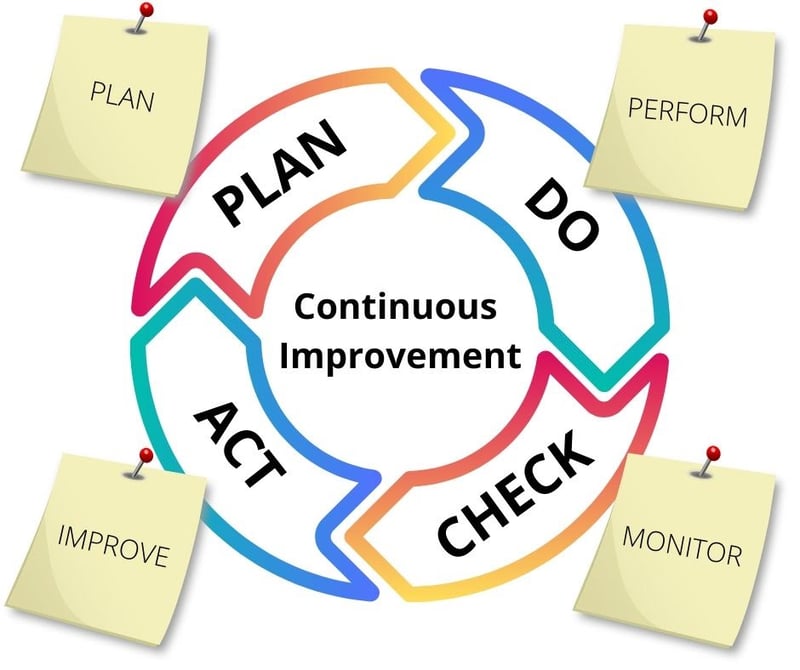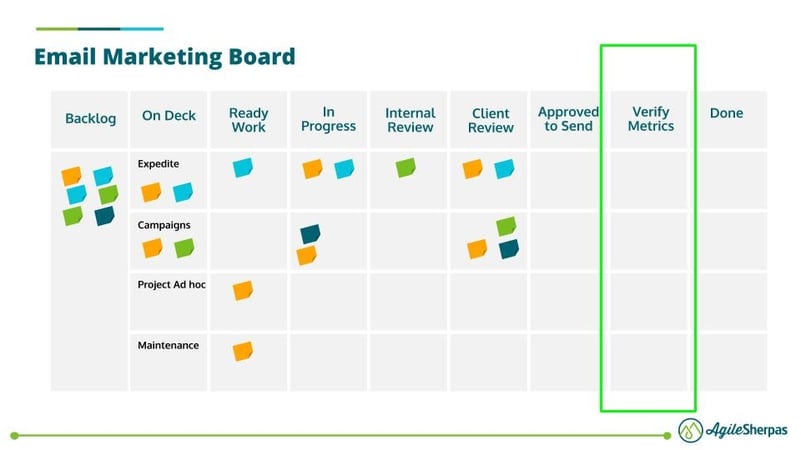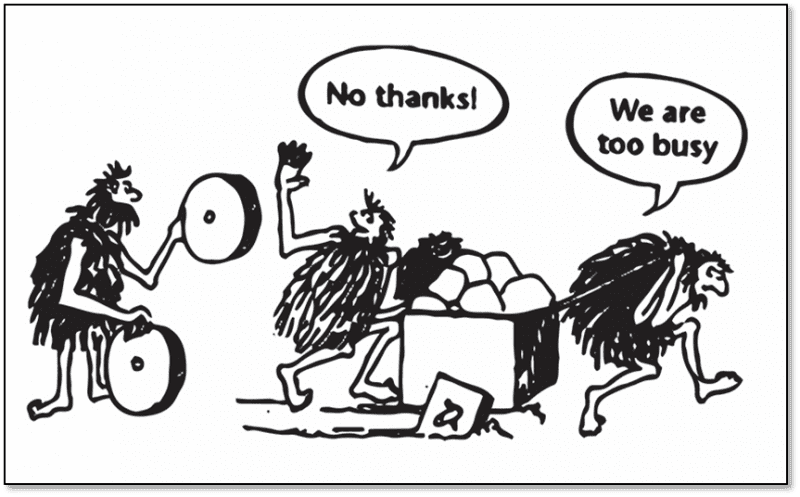What do Francis Bacon and Japanese manufacturers have in common? They both came to the conclusion that validating your assumptions before acting on them was a good idea.
All versions of the cycle of experimentation and improvement are based on a scientific method that was first introduced in the work of Francis Bacon, which he explained as "hypothesis–experiment–evaluation" or, in simpler terms, "plan–do–check."
As marketers are asked to move ever faster, it's easy to abandon anything that's not active doing. But this kind of neglect puts our projects, our ROI, and our sanity at risk.
Instead, we need to understand and embrace the full range of activities within the PDCA cycle so we can put it to work for us.
What is PDCA (Plan Do Check Act)?
PDCA (plan-do-check-act) was initially introduced as a quality control system in manufacturing during the 1940s in Japan. Shortly after, it was rolled out to a wider variety of industries.
An updated version of the PDCA can be traced back to the Tokyo Institute of Technology in the late 1950s. Another variation is OPDCA, where the O stands for Observation. This added step of observing the current condition corresponds to the principles of Lean manufacturing and can, to this day, be found embedded in the Toyota Production System.
Almost in parallel to PDCA’s emergence in the factories of Toyota in the 1950s, W. Edwards Deming developed the Deming Cycle. In the 1980s he evolved it into the plan-do-study-act (PDSA) cycle for learning and improvement. He claimed that the PDSA cycle was different from the Japanese plan-do-check-act (PDCA) cycle.
As an argument, he pointed out that their version was a quality control program, aimed at serving the management. He argued that “check” in English meant to hold back and was thus slowing the process while his PDSA was aimed at speeding the process up.
Today, PDCA is a valuable practice that's part of both Agile and Lean methodologies. It's also an integral part of effective project management, Agile or not.
PDCA has proven to increase speed and efficiency while decreasing project costs and risks associated with execution. These benefits extend to the management of marketing projects in a big way.

Now, let’s delve deeper into how exactly each of these stages manifests in our daily marketing work. You now know that PDCA was initially developed in the field of manufacturing. Yet, the method relies on widely applicable practices and, in many ways, common sense.
Steps in the PDCA Cycle
The PDCA model consists of the following steps:
Plan
In the planning phase, you must identify the problem or opportunity, analyze it, and develop hypotheses. During this step, it’s useful to run a SWOT (Strengths, Weaknesses, Opportunities, Threats) analysis and formulate the hypotheses based on the results. The final step of the planning phase consists of selecting a hypothesis to check. Your hypothesis includes defining the desired outcome, the KPIs, and the method of testing.
Do
In the PDCA cycle, the "Do" phase doesn't necessarily refer to the execution of the entire project. Instead, it refers to the part of the process during which we build the tools for experimentation.
"Doing" on a small scale allows us to test MVPs as potential solutions and discover which experiment performs best "in the wild." Our customers are most involved at this stage. They interact with and consume our MVPs, allowing us to observe and track their response.
Check
Checking means measuring the results after the experiment is over. It includes gathering the data required to formulate the following steps of the process. Now is the time to collate data, analyze results, measure effectiveness, and decide if the experiment supports the hypothesis or not.
The definition of done for a "Check" phase is a shared understanding of the valuable customer insights collected, as well as the definition of the next stage of development of the solution.
Act
Your team "Acts" by implementing the solution based on the assumptions that you proved or disproved in the previous step.
As the PDCA cycle does not have a clear beginning and end, it's conducive to repetition. In fact, it works best when it's implemented continuously. Through this mode of application, the improved state you reached at the final step becomes the baseline for the next iteration and so forth.
By keeping the wheel spinning, you're able to drive continuous improvement within your team on all levels.
Wide Applications of PDCA
You can implement the PDCA cycle as an integral part of your organization’s work and culture. It's simple to embed within a wide variety of processes, and it yields fast results. That's why PDCA is a favorite approach of organizations of all sizes and industries.
If you’re not part of a company-wide Agile transformation, you can start by bringing PDCA into potential areas of improvement on the team level.
For example, bring in the plan-do-check-act cycle as you:
- Define new work processes
- Kick off a new improvement project
- Develop a new or improved design of a product, service, or process
- Plan to collect and analyze data in order to prioritize and verify problems or root causes
- Establish a culture of continuous improvement
In these initiatives as well as others, you'll greatly benefit from the Deming cycle, as it provides a clear scientific approach towards the project. In other words, it encourages you to prove assumptions before acting on them. Consequently, this approach has also been lauded as being more cost-efficient, allowing teams to test solutions on a smaller scale and get results faster.
Plan-do-check-act in Agile Marketing
PDCA in Agile marketing is mainly focused on managing the value stream. Effective marketing isn't much different from manufacturing or delivering a product/service; it also struggles to improve efficiency, reduce costs and errors, and generate more value.
Marketing teams often struggle with:
- delivering on time because they’re interacting with many internal and external stakeholders and have many dependencies
- completing campaigns in a cost-efficient way
- preparing extensive reports and root cause analysis for management
- streamlining an efficient process, minimizing team idleness, and consistently increasing throughput
- aligning customer expectations with the business value of the organization
Adopting the PDCA model can bring significant improvements in all these areas.
PDCA in Internal User Stories
Imagine that your marketing team has to implement a new MQL (marketing qualified lead) qualification and automation process. Firstly, you need to think of a way to score leads properly (assess the right stage of the journey they’re in) and a way to deliver them to the sales team. This would include an automation tool for scoring, integration of the tool with the CRM, and a new reporting process.
Marketers translate this need into a user story for their internal customer in the structure:
As a sales team member, I would like to receive truly qualified leads from the marketing team in an automated way, directly in our CRM, so I can seize the opportunity to approach hot leads that are more likely to convert.
Plan-do-check-act can help teams execute on this internal user story in a more efficient way.
During the Planning phase, assess the problem, consult with sales and come up with a hypothesis (e.g. "If we create a bar of met requirements for the lead before it becomes an MQL, we’ll be sending sales only hot leads”).
In the Doing phase, test this hypothesis by using a sample of your database and applying the selected criteria on them before sending the MQLs to sales for review.
During the Check phase, receive feedback from sales and make adjustments if needed. If the sales team is happy with the MQLs, proceed to the Act phase by rolling out the new qualification. If they aren't, Act by amending the criteria and iterate until you reach the best solution.
This approach equally extends to customer-facing projects and user stories as well.
PDCA in Customer User Stories
In parts of the marketing department, such as Email Marketing, PDCA is often an integral part of how the team plans for customer outcomes, instead of just outputs.
Delivering a functional email campaign to the mailing list of customers is a necessary deliverable. However, without collecting data about the email campaign’s performance, there's no new learning. As a result, the team can't improve from one campaign to the next.

You can map this process to the PDCA cycle. During Planning, the email marketing team formulates an assumption about what their customer wants to receive. The team can present it as a user story, such as:
As a previous event attendee, I would like to receive a promo code with a discount offer so I can feel good about being recognized as a loyal attendee more easily justify attending these events again.
Within the Doing phase, the email marketing team crafts two potential emails with a promo code to operate as an A/B test that will go out to a limited group of the customer segment.
As a final Check, the team will collect data from the existing, limited release A/B test and determine which assumptions were proved and disproved. This data will influence the final, wider release email campaign that will go out to the entire customer base.
Finally, the team will Act to unleash their final, validated email marketing campaign to their entire mailing list using their learnings from the Check phase to influence the final deliverable.
As they learn more about their customers and aim to continually improve their email communication with them, the team will continue applying PDCA. This way, they can develop the tone of their copy, their email visuals, and their choice of email marketing platform.
Remember: it’s not iteration if you only do it once!
PDCA During Retrospectives
PDCA's applicability doesn't end with the team’s improvement of project work. It all applies to the way the team handles its own process kaizen as it manifests through their regular retrospectives.
In fact, the goal of any team retro is to build a plan of anticipated process experiments.
The group doesn't need to define the final solution right then and there. Still, they should suggest potential courses of process change and a way to test them out.

During the retro, the team will Plan for a process change that addresses a certain challenge and determine a way to Do the experiment in a low-risk way within the team.
At the next team retrospective, the team will Check on the results of this process change, voting to Start, Stop or Continue with it based on the team feedback. If their vote is to Continue with the practice, they will Act to embed it into their best practices for project execution going forward.
Benefits of the PDCA Model for Marketers
The implications of the PDCA cycle have the potential to translate into long term benefits for any marketing team. By embedding the plan-do-check-act cycle into existing processes, marketers stand to gain:
Improved Team Agility
Embedding a natural cycle of customer validation into every aspect of your teamwork gives your customer more chances to influence internal decision-making. Further, delivering in smaller increments that influence upcoming iterations gives the team more chances to react to changing customer demand.
PDCA is all about keeping the team on track to deliver consistent customer satisfaction!
Increased Efficiency
The PDCA model boosts marketing efficiency by allowing phases of work to go on in parallel. That way, no design team members sit idle, waiting for the copy for a piece of marketing collateral to be complete.
Instead, the team works in harmony, delivering small pieces of value to the customer just in time. In the long-run, an iterative process leads to the maximizing of existing resources. This results in a faster pace and better quality of marketing deliverables.
Culture of Continuous Improvement
Adopting this Agile practice will highlight opportunities for improvement on all levels of the organization and lead you to the path of continuous improvement.

When you embed this cycle into your process, the results of each iteration acts as the baseline for further evolution. Once the PDCA wheel starts spinning, there's no going back to being stagnant.
Better Risk Management
PDCA is a popular approach to minimizing risk on the project level. It encourages the team to monitor each stage of their campaigns in a controlled environment.
By maintaining strict control over the variables of each experiment, the team gets an opportunity to verify their ideas before rolling them out fully.
Budget Optimization
Delivering results in shorter time frames based on empirical testing and analysis has the potential to significantly reduce the financial investment in a marketing project. This optimization comes as a result of reducing the cost of delay and resources allocated to correcting major errors.
PDCA is the Key to an Agile Process
You’ve heard us say this before: reaping the full benefits of Agile marketing begins with adopting the Agile mindset at all levels of your organizations.
Implementing the plan-do-check-act cycle will bring you one step closer to truly embodying that Agile mindset at work. Its impact lies, in part, in how fast it brings palpable results and how quickly it can drive improvements within your team’s process.
Now, the first thing you need to do is Plan to embed PDCA into the execution process of your next project!
If you're curious to learn more about bringing experimentation into the way that you work with your team, check out our live, open online courses. We cover PDCA and other formats for iterative planning and execution in greater detail during our 8-week certification course on Agile marketing!



